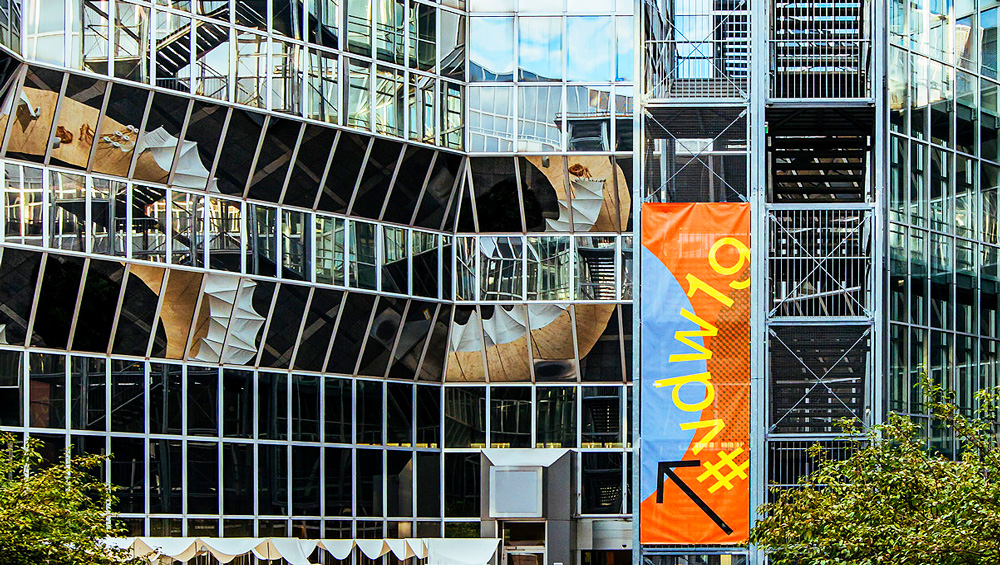
Vienna
27 September – 6 October 2019
by VERONICA SIMPSON
Design as an agent of transformation, a means of distilling something essential and enduring around identity – or both - is woven throughout Vienna Design Week 2019. But this year, the way this 10-day festival in the Austrian capital expresses that sense of purpose seems a particularly welcome antidote to much that troubles us.
With the construction industry responsible for about 40% of the world’s carbon emissions, the re-evaluation of existing buildings, the renewed appreciation of what lies under our noses, has to become more of a priority in sustainable city-planning. And one big factor in what, for me, makes VDW so appealing, is the way the festival chooses a previously disused or unloved building in a new district each year for its headquarters and, through a few, subtle design interventions - including great graphic design by festival stalwart Pascal Magino of Bueronardin - brings that building back to life. In this, and the practice of joining forces with that neighbourhood’s artisans, shops and galleries as programme partners or content producers, the festival guarantees new delights and discoveries not just for visitors but also for long-term residents.
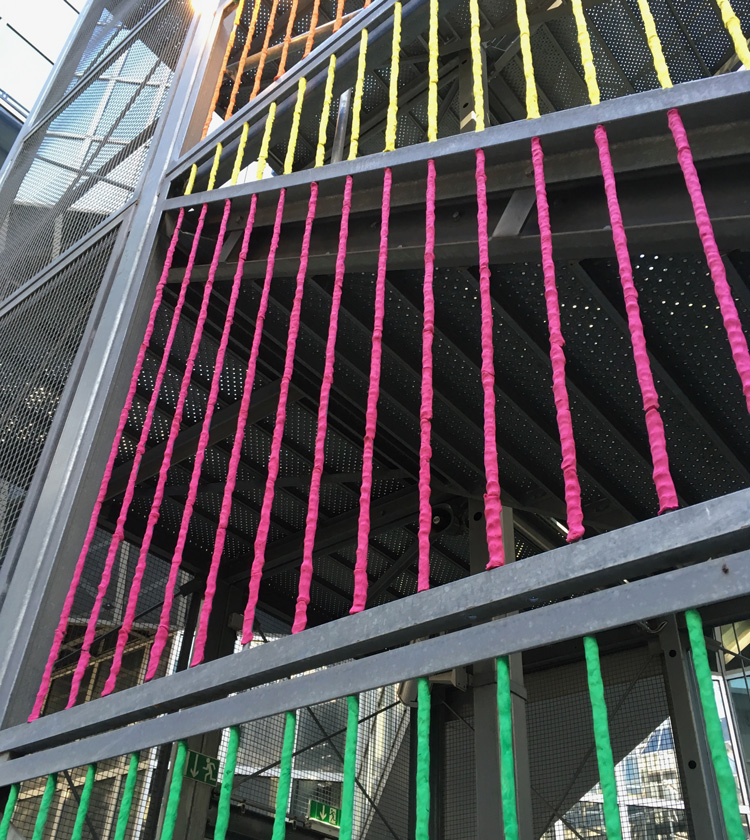
Diego Faivre. 475 Bars Covered in 2.375 Minutes. Photo: Veronica Simpson.
This year’s HQ is a cracker: a huge, mirror-panelled monster of a building that sprawls across Franz-Josefs-Bahnhof in the ninth district. It was built in 1978 for the Bank of Austria’s technical department, designed by Karl Schwanzer, seemingly one of the leading exponents of Viennese modernism, and expresses all the slick machine-age bravado, architectural ambition and corporate complacency of its time. Never much liked by the locals, the thoughtful interventions dreamed up for this show (by exhibition designer Robert Rüf and the various curatorial teams for each section) show it in a new light. Even the outdoor space is activated, with temporary pavilions, and a delightful artwork by the French designer Diego Faivre, who covers the bars of the building’s utilitarian fire escape in a rainbow spectrum of waterproof play-dough, titled 475 Bars Covered in 2.375 Minutes.
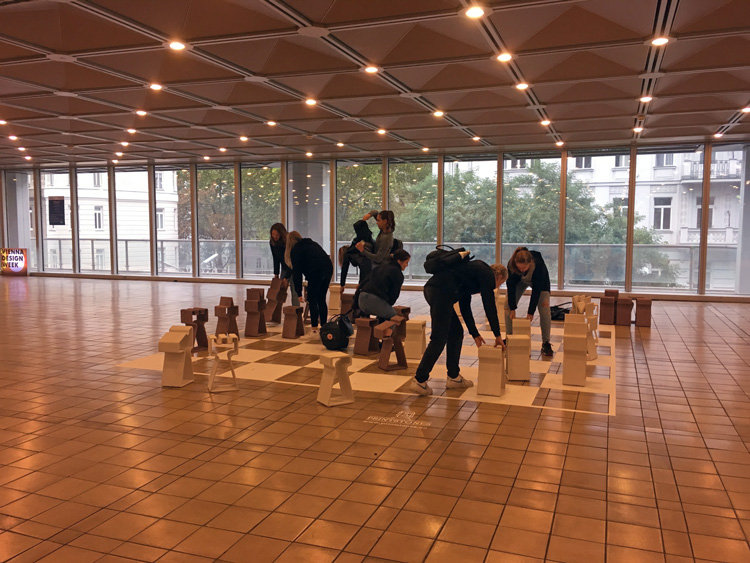
Vienna Design Week HQ, chess interaction, 2019.
Occupying only the ground and lower floors, arranged around a large, central, paved courtyard, the various exhibition spaces take full advantage of the building’s huge glazed lobbies and vestibules. From the inside, the reflective glass is translucent, allowing daylight to wash over every surface, and adding clear sightlines and ease of navigation to the building’s welcoming features. One vast, parquet-floored reception room makes an excellent space for the oversized chess, Scrabble and backgammon games laid out, inviting co-operation, teamwork and physical interaction with their 3D printed pieces, some big enough to sit on.
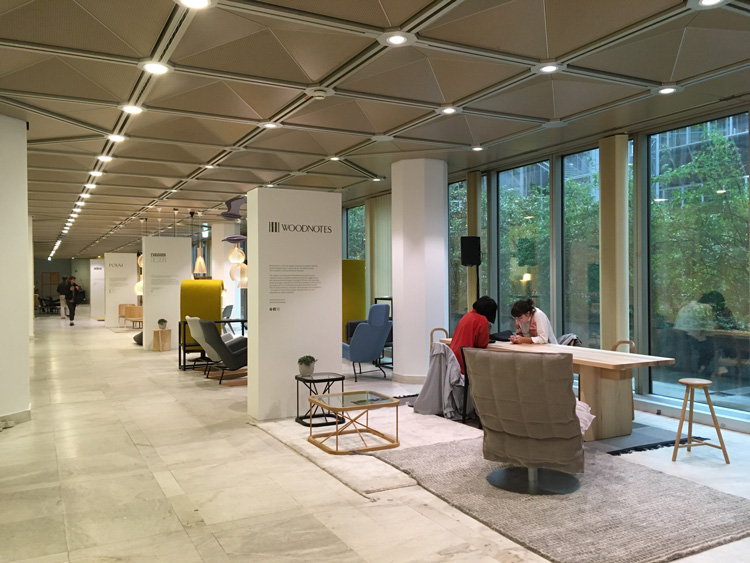
The Finland Lounge, Vienna Design Week HQ, 2019.
Another daylit vestibule has been turned into an elegant, extended lounge, the Finland Lounge, which this year’s country partner, Finland, has (somewhat opportunistically) filled with contemporary furniture. Who can blame it? This small Scandinavian country punches above its weight in terms of output and influence on global contemporary design and architecture. Its tasteful, mid-century modern DNA, organic forms and materials fit in surprisingly well to this flamboyant, late-20th-century structure.
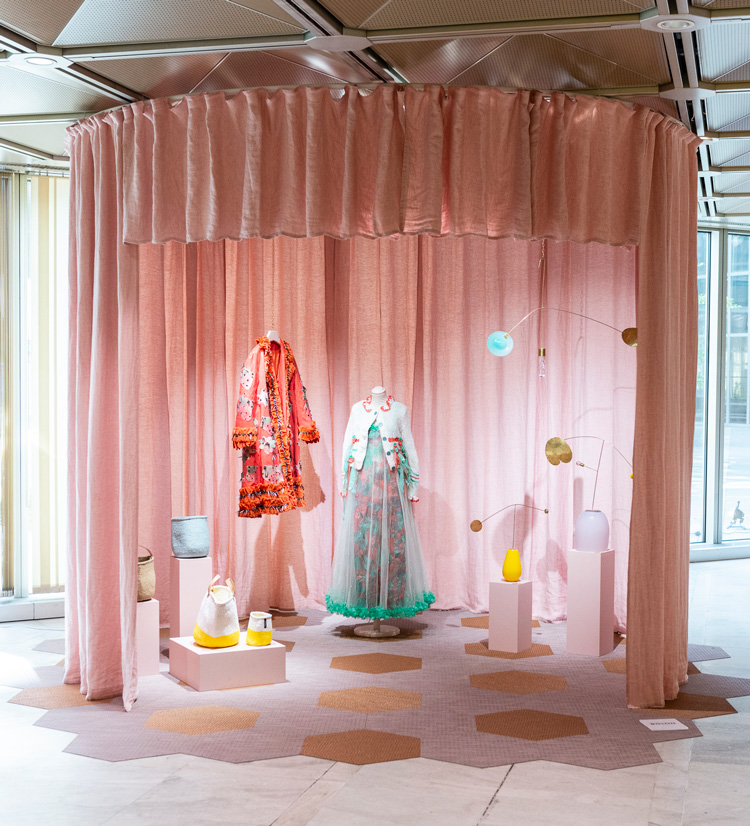
Wild at Heart selection, Vienna Design Week, 2019.
But Finnish design today isn’t all natural forms and tones, as the adjacent, colour-popping hues of bubble-gum pink and banana yellow show, in the special Wild at Heart selection, guest edited by the industrial designer Tero Kuitunen. Here, we see the more playful and experimental creations from the likes of textile artist Klaus Haapaniemi and designers Aamu Song and Johan Olin, whose Helsinki-based studio Company has interrogated traditional crafts from around the world and revived them with new and quirky inventions.
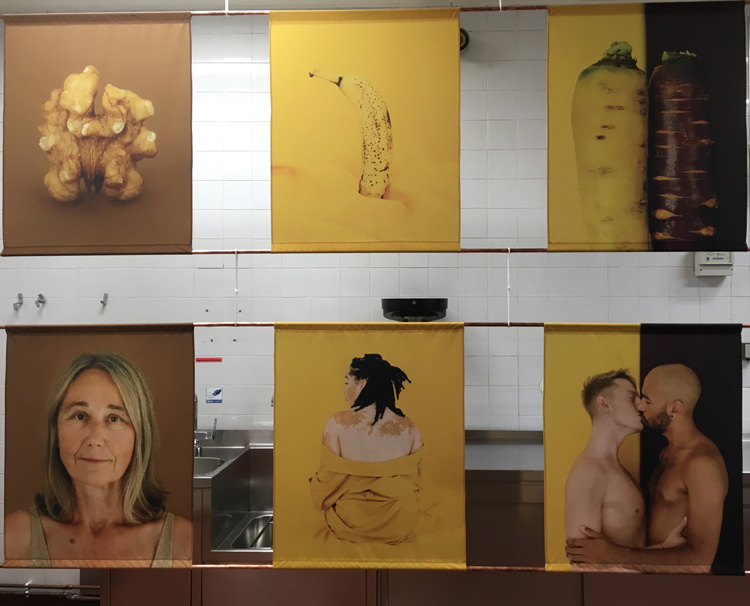
Amina Stella Steiner. Grown This Way: An Aesthetic Attack on a Societal Behaviour. Vienna Design Week, 2019.
The generous scale of this venue means that the themed areas have plenty of space, revealing the intelligent curation of each strand. Food in the city is an enduring and pressing issue, expressed via tours, talks and an exhibition of artworks and interventions, wittily displayed in the ceramic-tiled, industrial-scale catering spaces that comprise the former canteen kitchen. Grown This Way: An Aesthetic Attack on a Societal Behaviour is a thought-provoking call by artist Amina Stella Steiner to embrace the diversity and flaws of those fruit and vegetables not seen as fit for supermarket display, alongside a photographic celebration of variety and choice in human form. I also liked chmara.rosinke’s Mobile Kitchens display, showcasing the kind of DIY kitchens you could make yourself, come the apocalypse.
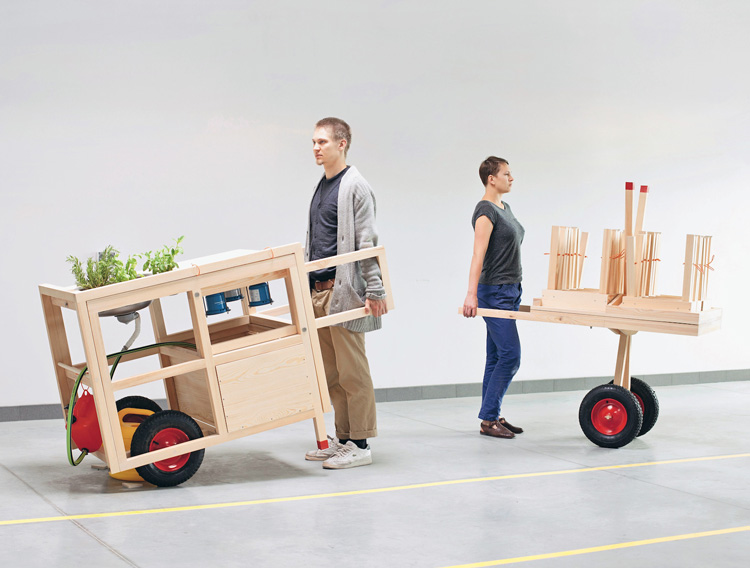
chmara.rosinke’s Mobile Kitchens display. © chmara.rosinke, Vienna Design Week.
Given the prevailing tensions around climate change, sustainability is rarely off the menu. But here it is tackled with wit and finesse by exhibits such as the design consultancy EOOS’s Circular Shower, for programme partner Vöslauer, an Austrian mineral water brand; developed for the brand’s spa, it turns the device’s plant-based filtration system into a decorative feature. Elsewhere, sustainable manufacturer Permanere displays its proposed 100-year washing machine, designed for longevity and ease of maintenance.
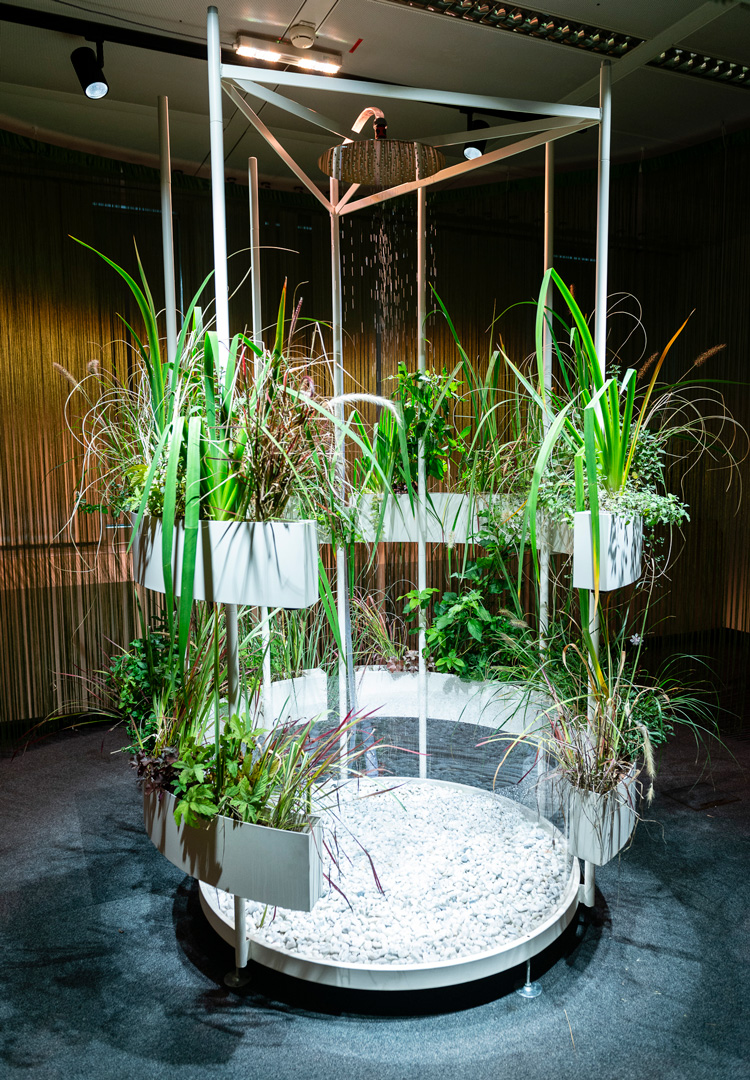
Circular Shower | EOOS. © Vienna Design Week, Kollektiv Fischka - Phillip Podesser, Vienna Design Week.
A more speculative – albeit entirely feasible – proposition is the Vegetable Living Room Takeover! from vegetable-growing evangelists Raiseaplant: a dark, windowless room is glowing with daylight-simulating LED lights beaming on to a series of tall planters containing tomatoes and peppers; with one of these, you could gather your own salad from the comfort of your sofa. As ever, programme partners – AKA sponsors – are expected to engage with design in innovative or delightful ways to justify their presence. That also goes for the Japanese brand MT masking tape, which commissioned artist sisters Petra and Nicole Kapitza to liven up the HQ’s bland, corporate interior with an explosion of colour in a “festival mix tape”.
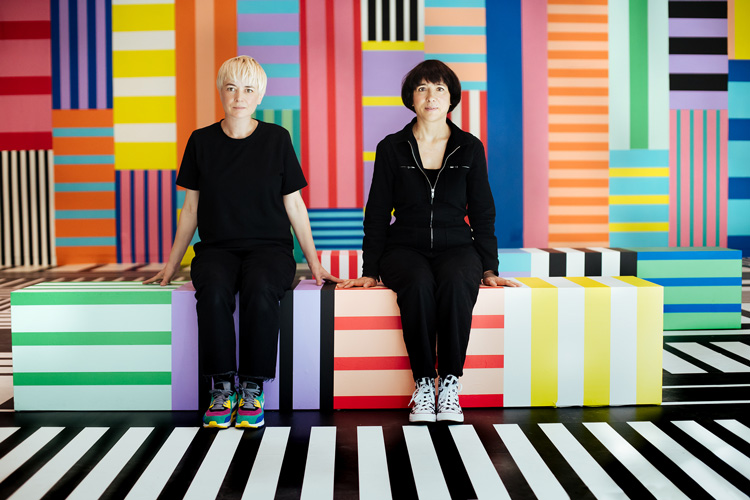
Petra and Nicole Kapitza. Festival Mix Tape. © Vienna Design Week, Kollektiv Fischka - Stefanie Freynschlag.
Speculative design is a strong feature of every VDW, thanks to the excellent Design Investigations department at Vienna’s University of Applied Arts, now under the stewardship of London’s RCA alumnus Anab Jain. In an exhibition titled Futures of Democracy?, surveillance – and how to hack it – is explored by the department’s students, both with a staged scenario of Austria as some futuristic authoritarian state and in an assortment of devices intended to thwart face-recognition technologies. These include a baseball cap whose peak is embedded with tiny, image-scrambling, infrared bulbs that light up whenever a camera is aimed at the wearer, and slim vials of seeds that could be thrown at CCTV cameras, to attract pigeons as feathered photo-bombers.
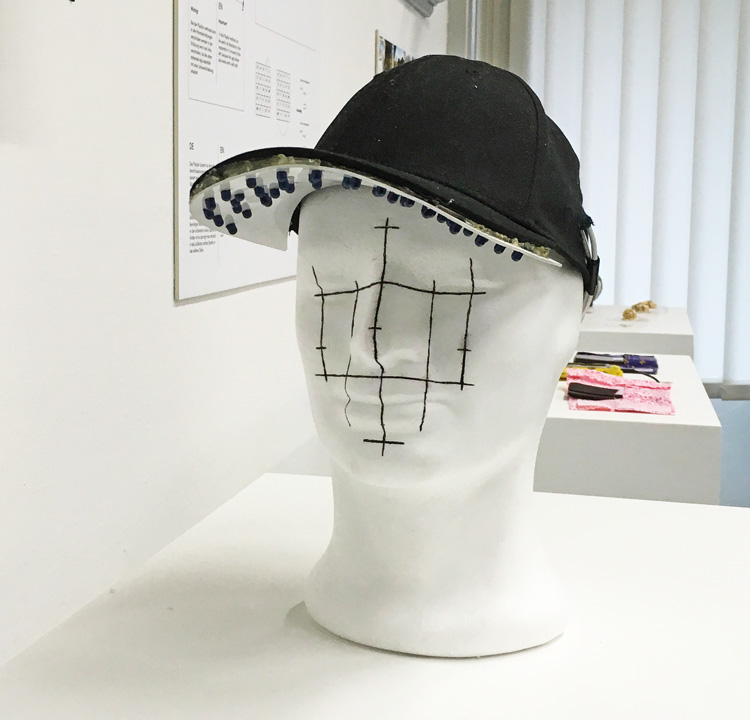
Baseball cap with face scrambling lights.
Stress-release is addressed by Ariane Shirvani’s A Tool for Interaction and Contemplation, a selection of beautiful objects to encourage introspection. It includes A Drop of a Second, a wide, copper bowl that slowly fills with water (like a watery equivalent of the sand-filled egg-timer) from the dish underneath it, thanks to a tiny perforation in its base: it is apparently inspired by ancient Persian irrigation devices. In a nearby room, a more experimental approach to ceramics and textiles is found in an exhibition curated by Gabriel Roland (co-curator of VDW’s Passionswege), featuring designers who push the boundaries of what one might expect of clay and fibre.
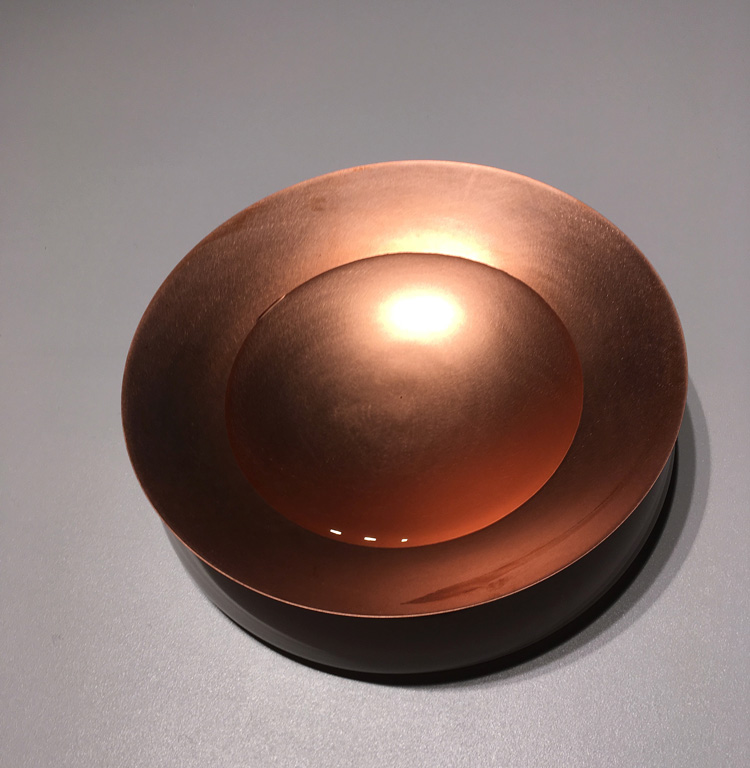
Arian Shirvani, A Drop of a Second, A Tool for Interaction and Contemplation. Photo: Veronica Simpson.
After the success of last year’s virtual reality presentations in the festival’s Debut section, this year the section is taken up with game design, with Press Start, an exhibition curated by Austrian game design guru Jogi J Neufeld, which includes three-day game design jams between schools and colleges from all over central Europe. Workshops and talks offer a rare opportunity for behind-the-scenes insights into the processes and inspirations behind game creation, not to mention the way game design technology is increasingly being applied in other fields, including medical research.
.jpg)
Debüt | Game Design. © Vienna Design Week, Kollektiv Fischka – Paulus Jakob.
VDW’s Laboratory strand sits within this section and brings professional game and graphic designers together – disciplines which, I am told, rarely overlap - resulting in some unusually thought-provoking games, including one, Left/Right, which reveals the consequences, intended and unintended, of political and personal decisions. VDW director and co-founder Lilli Hollein says: “We want to make people aware that gaming is relevant for more than recreational purposes. This is something I learned myself in researching game design over the past few months: the possibilities that lie within the architecture and structure and mind map of games goes far beyond just having a good time. Many people from science and research take the way games lead you towards a solution to help with things like diagnosis, for example.”
As usual, Hollien’s pioneering Passionswege strand, which entails the pairing of unrelated artists and designers with local manufacturers in VDW’s chosen district, brings unexpected delights. Product designers Studio Sain made the “perfect” collaborator according to master wood-turner Hermann Viehauser, resulting in a series of movable and covetable hand-turned mirrors, lamps and shelves.
-2.jpg)
Passionswege | Drechslerei Viehauser x Studio Sain. © Studio Sain, Vienna Design Week.
Some neighbourhoods are more blessed with traditional workshops than others, but the need to work with what is available (and who is willing to engage with the exercise) yields some interesting alchemies. For example, galvanizing specialists Galvanik, whose daily output seems to be creating metal mementos of the most ordinary flotsam – the only value for which is sentimental - inspired graphic and product designer Teresa Berger to think about the toxic effects of our plastic consumption, and the area that is most affected by it – the sea. In response, Berger created three sculptures inspired by coral, the main parts being ceramic, but the key marine elements rendered by galvanizing three of her chosen components – the bulbous end of a cotton bud, the dished part of a plastic spoon and the puckered knot of a balloon end – in metal.
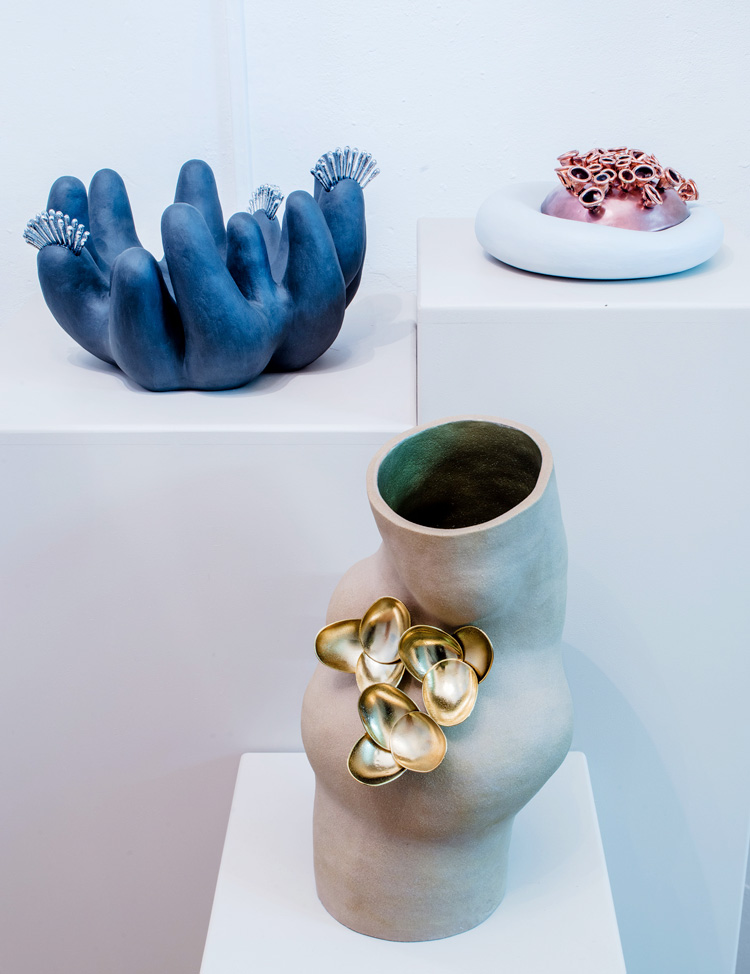
Teresa Berger x Galvanik Austria. © Vienna Design Week, Kollektiv Fischka - Kramer.
Galleries and museums throughout the city respond to VDW with special collections, talks and collaborations. Vienna’s outstanding design museum, the MAK, showcased EOOS’s groundbreaking new loo, among other sustainable designs in its Circular Flows exhibition. Developed in conjunction with Laufen, EOOS’s loo, the Urine Trap, diverts urine into its own plant filtration bed, converting the liquid’s nitrogen content into fertiliser, and ensuring that the sewage which then flows into the sea is far less toxic to plant and marine life. Vienna’s Imperial Furniture Collection, the Hofmobiliendepot – a museum with one of the finest furniture collections in the world – also hosted a delightful intervention within its extensive Biedermeier collection: modern, handmade items, from bird cages to cradles, were inserted into the room sets, chosen from the artisan output of the rural Werkraum Bregenzerwald craft village, to show a surprising degree of kinship between their design aesthetics.
Another highlight beyond the HQ was the large format photos of iconic Austrian contemporary architecture by Stefan Oláh at Rauminhalt Harald Bichler gallery. Gallery owner Bichler said: “Everyone in Vienna, all the museums, are so stuck in the past in Vienna – it’s all Klimt, Hoffman, Schiele – so Vienna Design Week is necessary to show design is a discipline that is still vital and evolving today.”
Hollein would say the misperception is skewed in other respects, too. She says: “We still have to make clear that we are not a fashion programme. Design here in Austria is still very associated with fashion or furniture.” Although this year, as last year, she has included a very small, selected presentation of Austrian product designs from the past 100 years, they range from shoes to plastic bottles, to show that “design is a tool for improving all aspects of the way we live,” she says. I’ll second that.